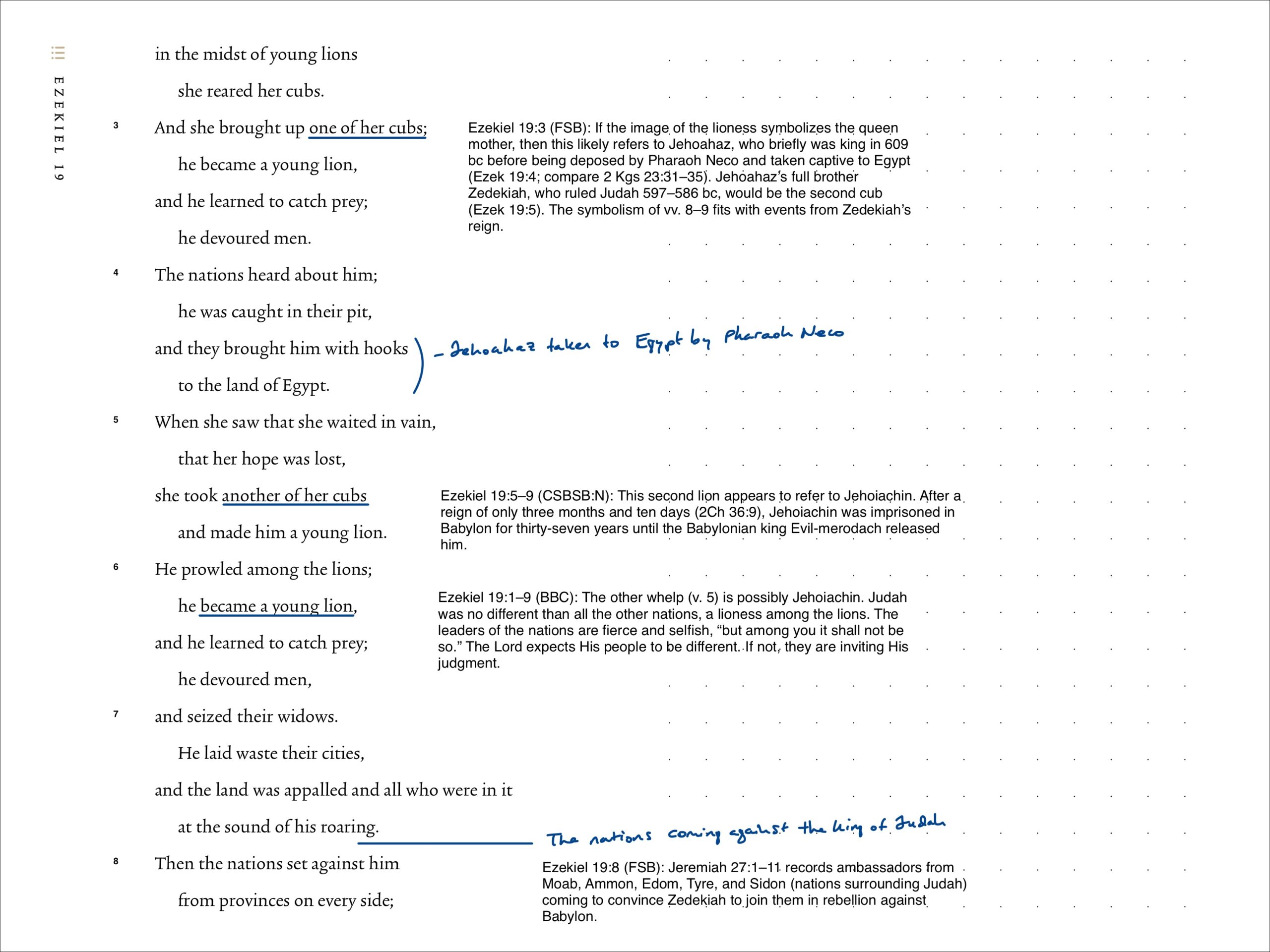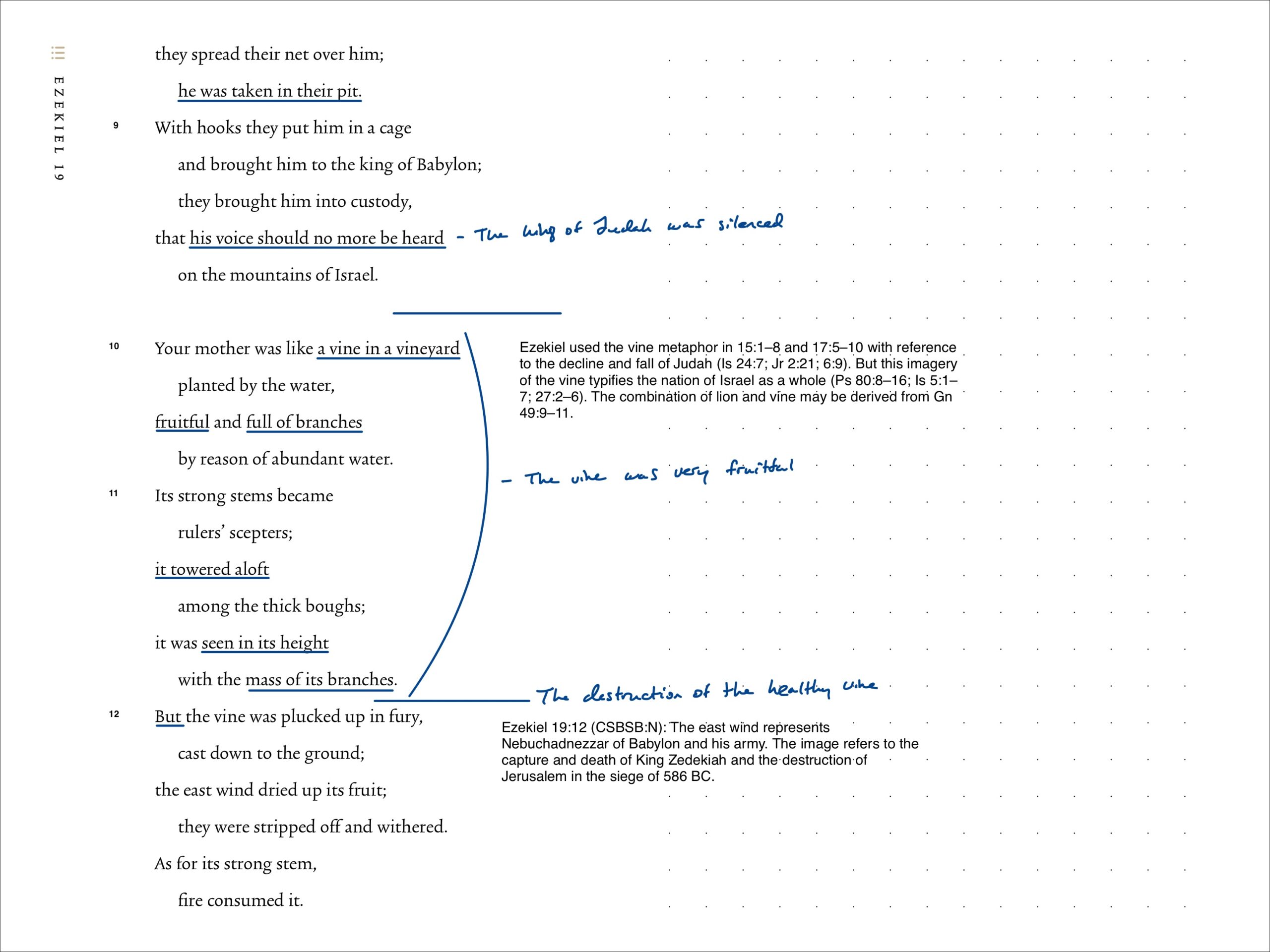| Date | Version | Reading Plan |
|---|---|---|
| @September 9, 2023 | ESV (2016) | ESV Prophets Plan 2023 |
Pericopes
- A Lament for the Princes of Israel
Notes
The chapter opens with God telling Ezekiel to take up a lament for the princes of Israel. In his lament, Ezekiel describes a mother lion, “A lioness!” (Ezek. 19:2), who reared young cubs. One of her cubs became a young lion. This likely represented Jehoahaz, who was king briefly in 609 BC before being deposed by Pharaoh Neco and taken to Egypt (Ezek 19:4; 2 Kings 23:31-5).
Ezek. 19:5-7 was of the second cub of the lioness. When she saw that waiting for her lost first cub was in vain, she took another of her cubs and made him a lion. There are multiple interpretations of who the second cub represents. Some say it is Jehoahaz’s full brother Zedekiah, who ruled Judah 597–586 BC. Others say it is Jehoiachin who reign for a brief 3 months and 10 days (2 Chron. 36:9) before being imprisoned in Babylon for 37 years prior to his release by king Evil-merodach.
Ezek. 19:8-9 describes the nations coming against the king of Judah. Jer. 27:1-11 records ambassadors from Moab, Ammon, Edom, Tyre, and Sidon (nations surrounding Judah) coming to convince the king of Judah to join them in rebellion against Babylon. These nations are indirectly responsible for the king’s downfall since he followed their ill-fated counsel. He was brought to Babylon so that “his voice should no more be heard” (Ezek. 19:9).
The imagery shifts in the remaining verses of the lament (Ezek. 19:10-14) to that of a vine. Ezekiel used the vine metaphor in reference to the fall of Judah (Isaiah 24:7; Jer. 2:21; Jer. 6:9), but this imagery typifies the nation of Israel as a whole (Ps. 80:8-16); Isaiah 5:1-7; Isaiah 27:2-6). This combination of the lion and the vine may also be derived from Gen. 49:9-11. The vine is described as initially fruitful (Ezek. 19:10-11), but is “plucked up in fury” by an east wind. The east wind represents Nebuchadnezzar of Babylon and his army. The image refers to the capture and death of King Zedekiah and the destruction of Jerusalem in the siege of 586 BC. The once-strong vine is consumed and there remains “no strong stem”, referring to the loss of the Davidic kingship. The lament of the lack of a strong stem or branch may hint at messianic expectation (see Isaiah 11:1). Thus ends the lamentation by Ezekiel (Ezek. 19:14).
Application
Ezekiel was to lament over the nation of Israel who fell due to her sin and transgression. She was once abundantly prosperous as a young lion and healthy vine, but had turned away from God and succumbed to idolatry.
It is difficult not to look at our country and modern context when reading this chapter. Founded on largely biblical principles, we have experienced years of growth, blessing and prosperity. But, through radical individuality, deconstructionism and revisionism, things are quickly shifting away from its original foundation. Understandably, one could get on a political soapbox with such topics (which I hope to avoid here), but I don’t think many people would affirm that things are going in the right direction.
However, in this chapter’s commissioning by God for Ezekiel to lament, He reveals His heart of grief over the nation of Israel. She was His beloved and He would much prefer she turn from her ways than have to mete our corrective destruction. No father wants to discipline his child and our Father is no different. In this, we should see how God’s sorrow should be our sorrow, lamenting over wayward nations as He does. We are to pray for those far away from Him to turn to Him; to mourn well and plead with the Lord for changed hearts on a national and global scale.
Scripture Journal Notes
Commentaries & Resources Used
- ESV Study Bible. (Wheaton, IL: Crossway, 2008)
- Faithlife Study Bible (Lexham Press, 2016)
- Believer’s Bible Commentary (Thomas Nelson, 2016)
- CSB Study Bible Notes (Holman Bible Publishers, 2017)
- Matthew Henry’s Commentary on the Whole Bible (Guardian Press, 1976)
- The Bible: A Reader’s Guide (Sterling Publishing, 2011)
- The Infographic Bible (Zondervan, 2018)
- ESV Digital Scripture Journal (Crossway, 2019)



